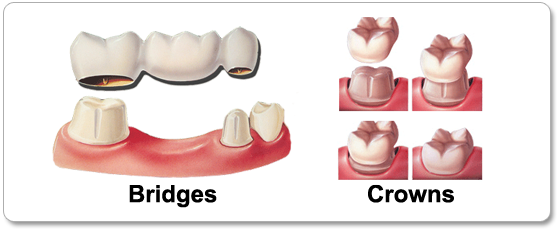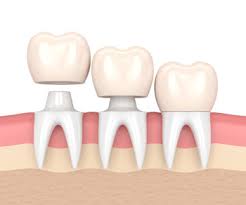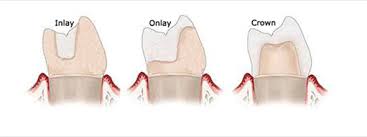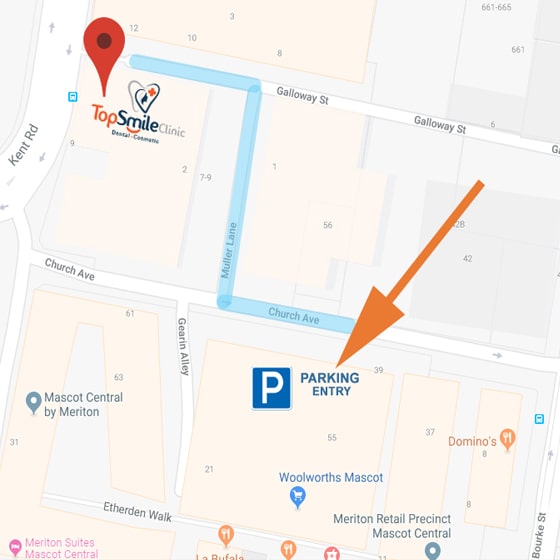Crowns & Bridges
Often after having a large cavity or filling, a tooth may start to become weak and in some cases begin to crack or break away. In these cases it is important to restore the tooth in a way that provides strength and support.
A crown is custom made for your tooth to cover and protect what is left and prevent further breaking.
Dental crowns have a reputation as being nothing more than an expensive filling. However, a dental crown is far more protective than a standard filling and can ensure the structural integrity of a tooth in ways that a standard filling cannot. Here’s when and why dentists will recommend the use of dental crowns
Dental crowns are designed to fit over the entirety of your tooth, providing all-over protection. Alternatively, fillings are designed to protect a small part of your tooth, usually a spot where decay or other damage has put your tooth at risk of further deterioration.
A crown is needed when your tooth has been extensively filled or it is cracked or broken, or when there is not enough tooth structure left for a traditional filling or an inlay or only. Crowns and bridges are cosmetic techniques to restore the appearance and function of your teeth, where the original tooth or teeth are badly damaged – or even missing.
Dental crowns specifically made and moulded to your individual tooth, act as protective caps for fragile teeth. Strengthening the external tooth surface, crowns can be made from different materials, varying in durability and appearance. Designed to last a long time, they are a reliable solution for weak, decaying or discoloured teeth.
Both dental crowns and fillings are useful for keeping your teeth healthy, but the complete covering of the tooth involved with having a dental crown fitted means that they offer a special kind of protection to the tooth.
If you have a small amount of damage to your tooth, such as a small cavity, a filling may be the best option. However, if the cavity is large, a crown or ceramic filling is likely to be a better solution. This is because a filling replaces the damaged piece of tooth, which is drilled away before the filling is placed. If too much tooth is decayed and needs to be removed by drilling, it can affect the structural stability of the remaining tooth. In these instances, a dental crown is recommended. Sometimes a ceramic filling is a better option also.
With a crown, there is no risk to the structure of the tooth because the entire tooth is encased inside the crown, protected from the force of chewing. The crown acts like a splint that holds the sides of the tooth together so that even if a large area is affected by decay, the structural integrity of the tooth can be maintained.
A dental crown is either a fixed cap that fits over your tooth or a full restoration (new tooth) which can be affixed to dental implants.
A tooth may need a crown if
-It has Cracks,
-A very large filling which is breaking down has weak bits of tooth which are likely to break
-Has had root canal treatment
-Severe misalignment and weakness
-An implant has been placed both options provide you with a strong, durable and natural
Looking result. Bridges
If you are suffering from tooth loss, decay or damage and feel that crowns or bridges are the solution for you, contact our team for an appointment
They are specialised fillings made in a dental laboratory that are cemented into your teeth.
They provide a useful alterative to a large filling as they are strong, tooth coloured and only require removal of any weakened part of the tooth.
These options can all be discussed with you at Top smile clinic.
At Top Smile Clinic, we create traditional crowns in addition to offering CEREC/ OR E4D restorations. CEREC/ OR E4D make same-day treatment possible by creating ceramic restorations using CAD/CAM technology in our practice while you wait.
We take a digital scan of your tooth and upload it into our software, which generates a custom dental crown that we mill on-site. We place the finishing touches on each crown, matching the colour and shade to the surrounding teeth.
We even offer CEREC/E4D same appointment restorations to minimise the number of appointments necessary to complete your dental procedure. We create crowns, inlays and on lays at our on-site milling machine during your appointment.
With the benefit of the advanced technologies at our disposal, we offer Same Day Crowns.
With the highly efficient Cerac/ or E4D/ or E4D and Trios Cad Cam system, we scan, design and mill crowns, bridges, veneers, inlays and on lays right here on the premises and fit them on the same day!
This is a great advancement on older methods, where several appointments were required. It is a wonderful relief for those who are pressed for time or inclination to attend recurring dental visits, as well as providing fast relief and treatment for damaged teeth.
Where you are missing a tooth, crowns on the neighbouring teeth can support a floating tooth made of ceramic to provide a natural looking replacement. This is called a bridge.
A bridge, by definition, is a link or connection between two permanent structures. A dental bridge is very similar in that it connects natural teeth on either side of the gap. This connection or bridge acts as your new tooth, closing the gap and restoring your smile. Bridges are often constructed of gold or metal foundations with porcelain fused to the foundation. This ensures that the bridge will support the normal functions of the mouth.
A dental bridge is a useful option to close gaps between teeth caused by missing teeth. It is used most commonly when the teeth on either side of the gap are improved by strengthening them with crowns. These crowns then form the pylons (supports) for our bridge. The gap may be the result of a tooth which is naturally missing or the result of a tooth extraction. Dental crowns are placed on both teeth on either side of the gap, providing both strength and support for the bridges. A fixed tooth is then joined in between the crowns in order to bridge the gap.
Dental bridges do just that – They bridge the gap created by one or more missing teeth. A crown replacing the missing tooth is joined to crowns made to fit over the adjacent teeth. In this way, the bridge, made up of three or more crowns, is supported by the teeth either side of the gap. At YFDL, we scan, design, mill and fit bridges, crowns and more, in-house in the same day, for the best comfort and convenience of our patients.
We offer several dental bridge treatments:
1-Traditional Fixed Dental Bridge
This involves the use of crowns and bridges and cannot be removed once it has been installed.
2-Cantilever Dental Bridge
This type of bridge may be used when someone has teeth remaining on just one side of the open space. A false tooth is anchored to an adjacent natural tooth or teeth. It can be a good choice for areas of the mouth that are not experiencing too much stress, such as the front teeth. Resin-Bonded Dental Bridge
This method is typically the least expensive.
A Bridge is used to replace multiple missing teeth. Bridges are made from two crowns that are joined to one or more false teeth in the middle to create a ‘bridge’ between numerous missing teeth. Also made from porcelain or zirconia, bridges create a long-lasting solution for any missing teeth as well as a natural look. With proper oral hygiene and regular dental exams,
Bridges and crowns can solve the problems created by missing and damaged teeth and last for years to com
If your tooth too weak to support a veneer but strong enough that it doesn’t require extraction, we will likely fit you with a dental crown. If your tooth was knocked out or has decayed to the point that it needs to be taken out, we will likely place a dental bridge there after the area has healed.
Aesthetics: It restores the shape, size, strength and appearance of your original tooth.
Protection: It provides the best protection for a weak tooth of any restoration.
Durability: It can last 15 years or longer if you care well for it.
Aesthetics: It fills in the gaps in your smile and in your face.
Restoration: It restores speech and chewing to full capacity.
Distribution: It distributes the force of your bite equally, taking the stress off of other teeth.
The benefit for both, and for all restoration dentistry, is to bring increased oral health to the mouth. Crowns can often be used to prevent further issues down the line, such as helping a fractured tooth regain its strength.
To get a free consultation about the best fit for your needs, call Top smile clinic
Comparing the two is kind of like comparing apples to oranges. A dental crown is often used to repair or replace one single missing tooth, while dental brides are more commonly used to substitute for several teeth. Crowns are typically attached to the top of a damaged tooth or a dental implant, while brides alternatively attach to two teeth that surround the are missing teeth.
When one or more teeth have been lost entirely, a dental bridge is recommended. However, crowns can be used for:
-Covering a dental implant.
-As a replacement for a filling that is too large
-Restore a tooth that is fractured or cracked
-Strengthen a tooth that has been weakened due to a root canal
Like most things in life, their longevity depends on the care given to them. Make sure to continue a dentist prescribed oral health regiment and ensure proper brushing and flossing.
Both dental crowns and bridges will last a good long while, though how long depends on a few factors.
Good oral health requires you to brush and floss on a regular basis because oral hygiene should be your number one priority if you want the procedures to last and be effective in the long run.
You also need to avoid eating unhealthy foods that have a hard surface because it might damage the crown or bridge. Avoid sticky foods to prevent decay and your crown or bridge should last from five to fifteen years. or even longer. It depends on your oral hygiene, dental care and maintenance
Today’s crowns and bridges are made of natural-looking composite materials that make them virtually indistinguishable from your natural teeth.
Both dental crowns and bridges will last a good long while, though how long depends on a few factors, Good oral health requires you to brush and floss on a regular basis because oral hygiene should be your number one priority if you want the procedures to last and be effective in the long run.
You also need to avoid eating unhealthy foods that have a hard surface because it might damage the crown or bridge. Avoid sticky foods to prevent decay and your crown or bridge should last from five to fifteen years.
Crown placement is typically completed in two visits. First, we will remove a thin layer of enamel coating and shape the tooth to provide room for the crown. This process allows the crown to be placed without crowding neighbouring teeth or creating an uneven bite. Then we make an impression of the teeth, which is sent to an on-site lab where the crowns will be made from the most advanced materials for long-lasting durability.
The dentist will fit a temporary crown, which is crafted from resin, to protect your tooth while the permanent crown is being made. At the second visit, the temporary crown will be removed and the tooth will be carefully cleaned before the permanent crown is applied using a strong adhesive.
The newer all porcelain crowns are an aesthetic improvement over older, porcelain fused to metal crowns as if the gum line would recede, the older crowns often showed a metal edge to the crown that originally was hidden from view.
Since all porcelain crowns have no metal, no markings are evident if the gum line recedes.
If a tooth that requires root canal therapy discolours, it is an indication that the nerve inside the tooth had died and blood pigments have broken down and been absorbed into the calcified tooth structure. By placing an all ceramic porcelain crown on the tooth, it can restore the tooth to match its neighbours.
If your crowns are worn down or damaged, give us a call so that we can plan replacements. We may need to remove the crown and provide you with a new temporary crown until your new permanent crowns are complete.
If you’ve had your crowns for several years, you may be troubled by their aesthetics. Older materials used to create crowns were not as natural-looking and lifelike as today’s modern crowns. Metal crowns and porcelain-fused-to-metal may be a giveaway that you’ve had dental work done, and we completely understand that you want your smile to look its best.
We are happy to examine your teeth and provide a recommendation as to whether your crowns should be replaced. Give our surgery a call.
Patients fitted with dental bridges are advised by dentists to avoid chewing extensively on foods such as raw vegetables, hard candies, and ice. These foods can cause damage to the bridge, which may require replacement if it cannot be repaired.
There are three types of dental bridges:
1: Traditional Fixed Bridge
A dental bridge is a false tooth, known as a pontic, which is fused between two porcelain crowns to fill in the area left by a missing tooth. This is known as a fixed bridge. This procedure is used to replace one or more missing teeth. Fixed bridges cannot be taken out of your mouth as you might do with removable partial dentures.
2: Resin Bonded Bridges
The resin bonded bridge is primarily used for your front teeth. Less expensive, this bridge is best used when the abutment teeth are healthy and don’t have large fillings. The false tooth is fused to bands that are bonded to the abutment teeth with a resin which is hidden from view. This type of bridge reduces the amount of preparation on the adjacent teeth.
3: Cantilever Bridges
In areas of your mouth that are under less stress, such as your front teeth, a cantilever bridge may be used. Cantilever bridges are used when there are teeth on only one side of the open space. This procedure involves anchoring the false tooth to one side over one or more natural and adjacent teeth.
Because temporary crowns are made from acrylic, which is less strong than the metal, ceramic or porcelain material of a permanent crown, you must take extra precautions. Limit the amount of chewing you do on the side of your mouth where your temporary crown is located.
Avoid chewing on hard candies, nuts and very crunchy fresh vegetables such as carrots on the same side of the mouth as your temporary crown. Until your permanent crown is in place, don’t eat sticky desserts or candy, including caramels, licorice, jelly beans, taffy, toffee and gummy bears, as they could pull the temporary crown off your tooth. Avoid chewing gum for the same reason.
Hot foods: Some individuals experience a mild-to-severe sensitivity in and around a crowned tooth when eating hot foods, particularly if they are affected by gum recession. If the problem persists, consult your dentist as the crown’s fit may require adjustment.
Cold foods: Although they do not harm your crown, such foods can trigger sensitivity similar to that caused by hot foods if any part of your gum recedes enough to expose the root above a crowned tooth. Your dentist may suggest that you use a toothpaste made especially for sensitive teeth; such toothpaste work by blocking the sensation traveling from the tooth to the nerves.
Sugary foods: Avoid constant exposure to sugary drinks, candy or gum, keep snacking to a minimum and brush or rinse your teeth after eating chewy or sticky foods such as dried fruit.
It is important to maintain excellent oral hygiene, making sure to brush and floss twice a day. Avoid biting on hard foods like nuts and candy that can potentially fracture the restoration.
At Top smile Centre, we focus on excellent oral health, but we also understand that looks are important to everyone. All restorative treatments we offer are done with an eye toward aesthetics. Our up-to-date materials and techniques make it easy for you to enjoy a smile that’s both healthy and beautiful.
May of the restorative and cosmetic procedures we perform use dental porcelain? You may think of porcelain as being a very delicate material, but dental porcelain is actually quite durable. It stands up to all the normal daily wear and tear, and with proper care, porcelain restorations can last for many years.
Porcelain veneers, crowns, bridges, and tooth-coloured composite fillings can all be shaded to closely match the colour of your natural teeth. The translucent quality of porcelain is also similar to that of dental enamel, so your new restoration will blend seamlessly with surrounding teeth.
This gives us the freedom to create a customized restoration that is made just for you. Now you can have dental work done without announcing it to the world!
If you’d like to learn more about our natural-looking custom restorations, please give our Top smile Centre a call. We’ll be happy to arrange a consultation to discuss the ways our restorative treatments can benefit you.
Thanks to our in-house CEREC/E4D milling machine and other pieces of dental technology, we can create a custom dental crown or dental bridge in a single visit to Top smile Centre.
Dental crowns and dental bridges can be treated just like your natural teeth when it comes to oral hygiene. Just brush twice and floss at least once daily to keep your smile repairs beautiful! We’ll also check your restorations at your routine visits to our Neenah, WI dentist office.
If you happen to have cracked, crooked, uneven or weak teeth, then a dental crown is the right choice for you. It’s also an effective procedure when you’re experiencing tooth decay and toothaches.
When it comes to having large gaps between the teeth, a person fits in as a candidate to have a bridge. However, ensure that you’re not suffering from weak bones because when you get the bridge implanted, your jaw bones should be healthy enough to support the volume of the device.
When you have gaps between teeth or are losing teeth, then it might be possible that you’re undergoing a bone degeneration process. Under such circumstances, you need to consult a dentist to get X-rays of your jaw structure and ensure that you’re a good fit for the procedure.
Choosing a qualified dentist for a dental crown or bridge is an essential task. The procedure is common and routine; however, make sure that your dentist practices international standards of treatment and care.
For example, medical certification is proof of your dentist being qualified for the job and you can also inquire about their educational history just to be sure.
As noted above, crowns and bridges serve different purposes.
If you have a deteriorating tooth, a crown might be the better option. However, if you’ve have missing teeth, a bridge is the better decision.
Ultimately, though, the wise choice is to seek the recommendation of your dentist regarding what procedure best fits your needs. Visit us at Kirkland Family Dentistry so we can help you make this decision.
The process of installing a crown or bridge takes 2 visits.
On the first visit the tooth will be reshaped by filing down the enamel so that the crown can be placed over it. You will be given a local anaesthetic before this part of the procedure so that you do not experience any discomfort.
Once the tooth has been reshaped, a mould will be taken of that tooth and the surrounding teeth. This mould will be sent to a dental lab so that your new crown can be made so that it fits in the spot created for it and looks the same relative to the surrounding teeth.
Before leaving, your dentist will fit you with a temporary crown until your permanent crown is ready.
The crown takes about 1 week to be returned. At this time you will have another appointment to place and fit the permanent crown. The tooth will be placed using a cement to ensure the tooth sits in place.
When you look in the mirror, you will see your old smile back. Crowns are durable and strong. You should care for it as you would any of your other teeth with regular brushing and flossing.
Bridges go by unit, each unit is a tooth replacement, ranges between $2200 to $ 5650, At Top smile clinic is only $ 1450 per unit.
Bridges or fixed partial dentures are devices which fill the gaps where teeth are absent. Fixed bridges are bonded into place and can only be removed by a dental professional. Removable bridges, as the name implies, can be taken out and cleaned. Fixed bridges offer more stability than their removable counterparts.
Why do I need dental bridges?
Oral functionality and appearance are important reasons for wearing bridges. A bridge helps support your lips and cheeks. The loss of a back tooth may cause your mouth to sink and your face to look older.
Dental health is the most important reason for a bridge. Teeth were designed to complement each other. Unusual stresses are placed on the gums and other oral tissues when teeth are missing, causing a number of potentially harmful disorders.
Brushing twice a day and cleaning between your teeth daily help prevent tooth decay and gum disease that can lead to tooth loss. Pay special attention to cleaning teeth that fit under the denture’s metal clasps. Plaque that becomes trapped under the clasps will increase the risk of tooth decay. We will demonstrate how to properly brush and clean between teeth. Selecting a balanced diet for proper nutrition is also important.
Don’t worry; we take care of removing all types of acquired stains from your enamel by making a good prophylaxis prior to the bleaching procedure.
We sure can, most common causes of those white stains on your teeth come from decalcification of the enamel and fluorosis.
Those stains can either be removed, if superficial, by micro abrasion of the enamel layers where the stains are. Or, if micro abrasion is not the answer, we can provide a bleaching technique on which we will match the colour of your teeth to the same as the white stains, making it almost impossible to notice and giving you a far more beautiful teeth colour.
There may be no symptoms. If symptoms occur, they may include:
Tooth pain or achy feeling, particularly after sweet, hot, or cold foods and drinks visible pits or holes in the teeth Signs and tests
Most cavities are discovered in the early stages during routine check-ups. The surface of the tooth may be soft when probed with a sharp instrument. Pain may not be present until the advanced stages of tooth decay. Dental x-rays may show some cavities before they are visible to the eye.
Crowns are specially made and custom fitted. They fit around and over your own tooth structure; they seal and strengthen the tooth. They are advised on teeth that have
Fractures within the tooth structure Very large fillings Teeth that have been root treated.
If a Top smile clinic dentist decides that you are in need of a full crown, there are a few different options for the repair of your tooth. These options include a full porcelain crown, porcelain fused to metal crown, or a full gold crown. We will discuss these options with you and help you determine which of these options is the most appropriate for your situation. You can be comfortable in knowing that your new tooth will be virtually unnoticeable and will flawlessly complement the rest of your smile.
Full Metal / Gold Crowns
Porcelain Fused to a Metal Cast
Full Porcelain Crowns
Porcelain Fused to a Zirconia Crown
Tooth decay is one of the most common of all disorders, second only to the common cold. It usually occurs in children and young adults but can affect any person. It is a common cause of tooth loss in younger people.
All our crowns are made by ceramists and technicians within Australia with Australian materials, less expensive crowns are generally made out of Australia to substandard criteria, using cheaper materials and by laboratories with less attention to detail.
Crowns can be made of gold, porcelain veneered over gold or all porcelain. Different teeth and patients have different requirements and these need to be discussed with your dentist at your consultation appointment.
Crowns and Bridges are mostly made of zirconia or porcelain which are fused to metal for
Strength and are made to perfectly match the natural colour of your teeth.
There are two different types of Crowns. One option is to make a covering which is fitted over a damaged tooth to enhance its existing structure. Another option is the full restoration (similar to a new tooth) which is affixed to a dental implant. Both options are extremely strong and functional. While a crown can be more expensive than a standard filling, Dental Crowns provide a longer-term prognosis for restoring your tooth.
A dental bridge is a good choice for people who are missing some teeth and are able to commit themselves to proper dental hygiene. Having a dental bridge placed in the mouth can help prevent further tooth decay and gum disease. It can also stop the remaining teeth from spreading further apart.
How a dentist makes a crown for a patient-
1) Tooth preparation,
2) Taking the impression,
3) The temporary crown and
4) Cementing the permanent crown.
The crowning process usually takes two visits.
The first appointment involves:
1) Preparing (shaping) the tooth,
2) Taking its impression and
3) Placing a temporary crown.
The time needed to perform these steps can range from 30 minutes to an hour.
During the time period between the two appointments, a dental laboratory will fabricate the crown. Two weeks or so are usually allotted for this process.
When the patient returns for their second visit, the dentist will cement the finished crown into place. This step can usually be completed in about 20 minutes or so.
That means all of your appointments together, spaced about two weeks apart, will take somewhere on the order of an hour to an hour and a half of actual chair time.
























































